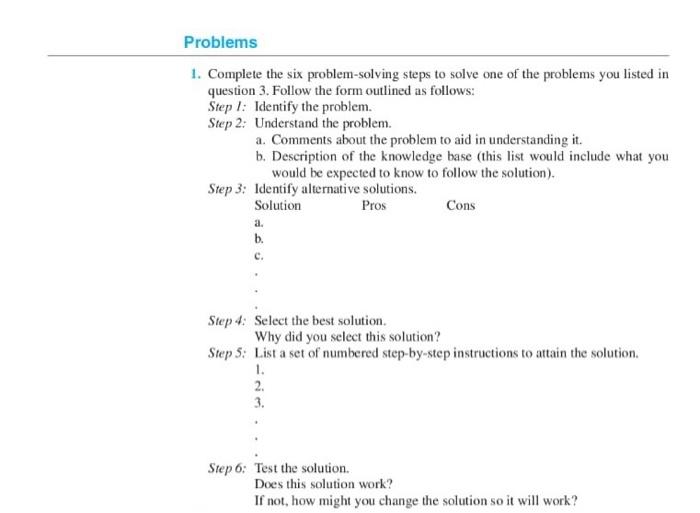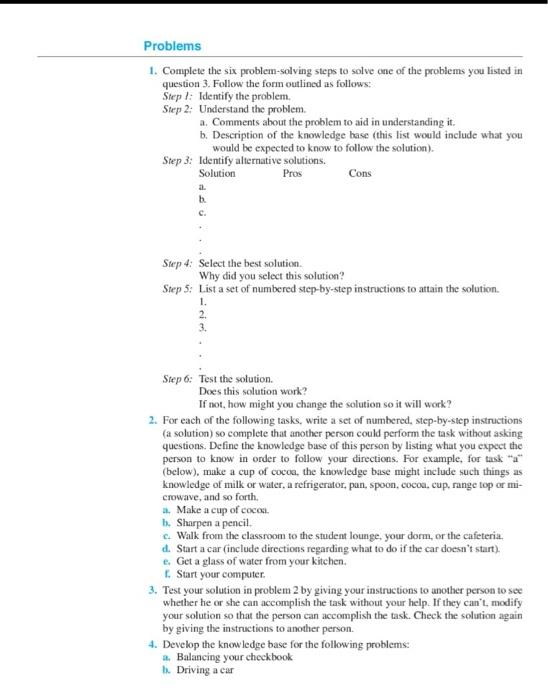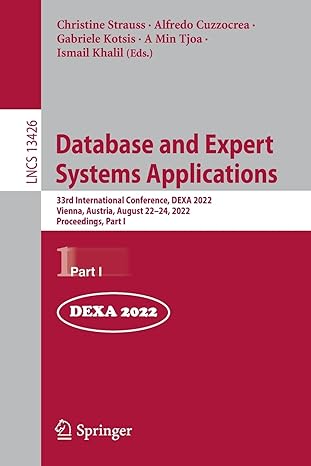base on the question 3

1. What are the six steps of problem solving? 2. What is an algorithmic solution to a problem? 3. Name three current problems in your life that could be solved through an algorith- mic process. Explain why each of these problems is algorithmic in nature. Problems 1. Complete the six problem-solving steps to solve one of the problems you listed in question 3. Follow the form outlined as follows: Step 1: Identify the problem. Step 2: Understand the problem. a. Comments about the problem to aid in understanding it. b. Description of the knowledge base (this list would include what you would be expected to know to follow the solution). Step 3: Identify alternative solutions. Solution Pros Cons a. b. Step 4: Select the best solution. Why did you select this solution? Step 5: List a set of numbered step-by-step instructions to attain the solution. 2. 3. 1. Step 6: Test the solution Does this solution work? If not, how might you change the solution so it will work? 2. For each of the following tasks, write a set of numbered, step-by-step instructions (a solution) so complete that another person could perform the task without asking questions. Define the knowledge base of this person by listing what you expect the person to know in order to follow your directions. For example, for task *** (below), make a cup of cocoa, the knowledge base might include such things as knowledge of milk or water, a refrigerator, pun, spoon, cocon, cup, range top or mi- crowave, and so forth. Make a cup of coco 1. Sharpen a pencil c. Walk from the classroom to the student lounge, your dorm, or the cafeteria. d. Start a car (include directions regarding what to do if the car doesn't start), e. Get a glass of water from your kitchen. 1. Start your computer 3. Test your solution in problem 2 by giving your instructions to another person to see whether he or she can accomplish the task without your help. If they can't modify your solution so that the person can accomplish the task. Check the solution again by giving the instructions to another person 4. Develop the knowledge base for the following problems a. Balancing your checkbook 1. Driving a car Problems 1. Complete the six problem-solving steps to solve one of the problems you listed in question 3. Follow the form outlined as follows: Step 1: Identify the problem. Step 2: Understand the problem. a. Comments about the problem to aid in understanding it. b. Description of the knowledge base (this list would include what you would be expected to know to follow the solution). Step 3: Identify alternative solutions. Solution Pros Cons a. b. Step 4: Select the best solution. Why did you select this solution? Step 5: List a set of numbered step-by-step instructions to attain the solution. 2. 3. Step 6: Test the solution. Does this solution work? If not, how might you change the solution so it will work? is an algorithmic solution to a problem! 3. Name three current problems in your life that could be solved through an algorith- mic process. Explain why each of these problems is algorithmic in nature. 4. What is a heuristic solution to a problem? 1. What are the six steps of problem solving? 2. What is an algorithmic solution to a problem? 3. Name three current problems in your life that could be solved through an algorith- mic process. Explain why each of these problems is algorithmic in nature. Problems 1. Complete the six problem-solving steps to solve one of the problems you listed in question 3. Follow the form outlined as follows: Step 1: Identify the problem. Step 2: Understand the problem. a. Comments about the problem to aid in understanding it. b. Description of the knowledge base (this list would include what you would be expected to know to follow the solution). Step 3: Identify alternative solutions. Solution Pros Cons a. b. Step 4: Select the best solution. Why did you select this solution? Step 5: List a set of numbered step-by-step instructions to attain the solution. 2. 3. 1. Step 6: Test the solution Does this solution work? If not, how might you change the solution so it will work? 2. For each of the following tasks, write a set of numbered, step-by-step instructions (a solution) so complete that another person could perform the task without asking questions. Define the knowledge base of this person by listing what you expect the person to know in order to follow your directions. For example, for task *** (below), make a cup of cocoa, the knowledge base might include such things as knowledge of milk or water, a refrigerator, pun, spoon, cocon, cup, range top or mi- crowave, and so forth. Make a cup of coco 1. Sharpen a pencil c. Walk from the classroom to the student lounge, your dorm, or the cafeteria. d. Start a car (include directions regarding what to do if the car doesn't start), e. Get a glass of water from your kitchen. 1. Start your computer 3. Test your solution in problem 2 by giving your instructions to another person to see whether he or she can accomplish the task without your help. If they can't modify your solution so that the person can accomplish the task. Check the solution again by giving the instructions to another person 4. Develop the knowledge base for the following problems a. Balancing your checkbook 1. Driving a car Problems 1. Complete the six problem-solving steps to solve one of the problems you listed in question 3. Follow the form outlined as follows: Step 1: Identify the problem. Step 2: Understand the problem. a. Comments about the problem to aid in understanding it. b. Description of the knowledge base (this list would include what you would be expected to know to follow the solution). Step 3: Identify alternative solutions. Solution Pros Cons a. b. Step 4: Select the best solution. Why did you select this solution? Step 5: List a set of numbered step-by-step instructions to attain the solution. 2. 3. Step 6: Test the solution. Does this solution work? If not, how might you change the solution so it will work? is an algorithmic solution to a problem! 3. Name three current problems in your life that could be solved through an algorith- mic process. Explain why each of these problems is algorithmic in nature. 4. What is a heuristic solution to a











